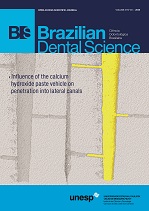Comparison between open and closed-tray impression techniques on the implant transfer accuracy
DOI:
https://doi.org/10.14295/bds.2018.v21i3.1568Abstract
Objective: This in vitro study aimed to determine and compare the dimensional accuracy of open and closed-tray impression techniques for implant-supported prosthesis. Material and Methods: On a edentulous master model, four external hexagonal implants were parallelly installed and associated with four multi unit coping transfers and four multi unit rotational caps. A master superstructure was constructed and splinted all implants (control group). Five customized trays were constructed to perform ten open (n=5) and closed-tray (n=5) impressions. The obtained models were submitted to the dimensional analysis on three points in the center of the labial face of each implant (A, B, C, and D) with the aid of Stereoscopic Magnifying Glass with x60 magnification. The vertical misfit between the metallic structure and the implant analogues was measured on each point. The obtained results were submitted to Dixon’s normality test and Kruskal-Wallis test for independent samples (p < 0,05) with the aid of Bioestat 5.0 software. Results: The means and standard deviation were: open tray technique – 24.6474 ± 14.8883 µm; closed-tray technique – 26.2257 ± 9.7421 µm; and control group 22.445 ± 7.7106 µm. Conclusion: The accuracy of open and closed-tray impression techniques showed no statistically significant differences and both techniques were effective for implant transfer.
Downloads
Downloads
Additional Files
Published
How to Cite
Issue
Section
License
Brazilian Dental Science uses the Creative Commons (CC-BY 4.0) license, thus preserving the integrity of articles in an open access environment. The journal allows the author to retain publishing rights without restrictions.
=================




























